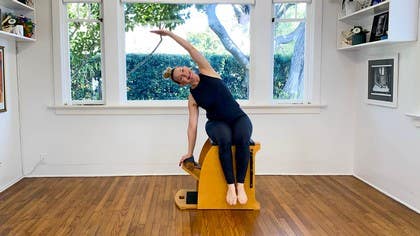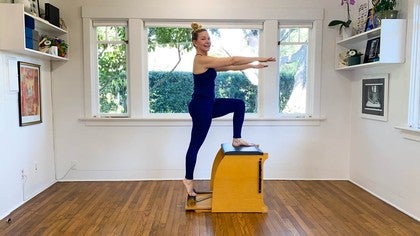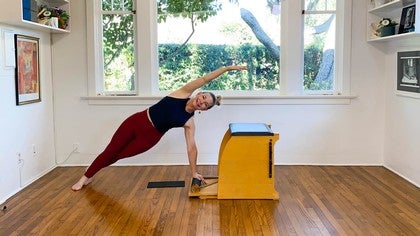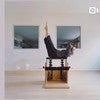Description
About This Video
Transcript
Read Full Transcript
Hi everyone. Amy Havens here. Very excited to present some Wunda Chair material for you. This is a three-class progression and kind of focused more for a little bit more of your newer to the Wunda Chair, but if you're a veteran of the Wunda Chair, please, you're invited to come and play as well. My idea with the progression is to help you feel how entry-level material kind of is a mainstay throughout all of the exercises.
Think of flexion, side bending, rotation and extension and you'll see elements of that throughout. This first class, there aren't many spring changes, so it kind of keeps things a little bit easy in that realm. Class two and three, there are more spring changes, and I'll tell you why at that point. I'm on a Balanced Body chair, low chair, pretty standard. You can use a Gratz chair, you can use a combo chair.
Springs are different on all the chairs, right? And peak also. So what I'm using to get us started, to warm us up, get us connected is one spring on the lowest setting. You will need a yoga block for this class and I've got a pad here and we'll be using that for some kneeling work too. So let's get started.
I want everyone to come down on your floor and settle in on your back. We're gonna dive right in to some connections, everyone. One of my favorite things to kind of teach. Get the arches of your feet on your pedal, bring it down. And this theme really is throughout all of the progressions, is feet to seat, okay?
I know it's a little cheesy, but the feet to the seat. So I'm on my arches. I want you to be with a little bit of a space between your knees. Level pelvis position, ribcage down, back is relatively relaxed, just a little bit of an engagement of your abdominals, but we're really basically pressing the pedal down with the feet. And as you press that pedal down, you'll hopefully start to feel how the muscles around your seat are naturally responding to that presser, okay?
So let's take three breath cycles together. Big breath in. And exhale. Maybe just focus on your diaphragm, right? That nice upper abdominal area.
Inhale, the diaphragm stretches down. And exhale, it comes back up to the ribs. And one more time. We're gonna keep the breath going and now start to move the pedal. Just little bit of lift with the pedal and press it down.
So what we're doing here is we're just kind of feeling, what does that feel like to let that pedal come up into the arch of the feet. Not too much, guys. And press down. So the pressing is coming from the feet, but it's mainly from here. I engage the seat and that pulls the pedal, okay?
So again, seat to feet, feet to seat. Couple more like this and I want you to start kind of putting your mind on what that spring is doing. The spring, keep the pedal down for a moment, the spring is long right now, it's also pulling toward you. You are pulling it toward you when the pedal's down. When you're lifting the pedal up, that spring is going in toward the chair.
When you're bringing it down, it's coming toward you. I'll refer to that several times. Spring goes in, spring comes out. Let's keep the pedal down. Quick warm-up on the shoulder girdle.
Raise those strong arms right up to the ceiling, shoulder blades are flat. Now, protract your scapula, reach your arms as high to the ceiling as you can, feel how the scapula is spread and then the opposite that, scapula come back on your back, flat on the floor. Let's breathe with that. Inhale, arms up. Exhale, scapula back.
Inhale, to the ceiling. Exhale, to the floor. Twice more. Inhale. Exhale.
Align your eyes straight to the ceiling. How are your feet and seat connections doing? And exhale, scapula down. Lower your arms, everyone. I want you lift the pedal up.
Remember, that spring is going into the chair. Nice and soft here. And just hug your knees. So hopefully, you've got a wow feeling in your feet, a little bit of work back here in your seat. We're gonna come up and we're coming up for seated leg pumps.
Changing things up. Now, I want you to reach in and I like on my chair to do two low springs for my footwork. Kind of not too heavy, but enough that your legs will feel some effort. You could also do one middle and one low. So let's come to have a seat.
Now, I like to teach the pedal coming down first. Get yourself standing on your pedal in the pilates V, which we all know. Balls of feet on the pedal, toes are apart and your heels are together. And just take a quick check here, everyone. That feeling that you had on the floor just a minute ago should be happening here.
Feet pressing the pedal. You might feel some awareness hopefully in your seat. Seat to feet. For this first class, let's just put our hands right here by the front of the chair. Breathing in when the pedal is down, springs are open.
Exhale, we pull that pedal up, springs go inside. Here we go. So I like to also kind of think about the springs like my diaphragm muscle. I know, I'm a little weird. That when I inhale, I'm stretching, I'm strengthening that diaphragm, it's pulling down.
And then as I exhale, that diaphragm's coming up, the strength there. Inhale. Exhale. So, objectives. 10 himes, 10 reps, heels together, look straight ahead.
Exhale. Press. Pull. One more press down, everyone. Hold the pedal down.
Change the foot position. Back onto the arches of the feet just like we were when we were down. You could have a little space between your feet. Orient yourself sitting tall, eyes looking straightforward. Spring is open, that's our inhalation.
Exhale, we close the spring, we engage the abdominals, diaphragm is coming up. Inhale. Exhale. So if that diaphragm stuff is not making sense, don't worry. Plenty of tutorials around to check that out.
But it's really what the muscle direction's doing. Lengthening on an inhale, it's relaxing on an exhale. What's not relaxing are the abs. On an exhale, those are working strongly. Two more of these leg movements.
Pull up, press down. Pull up, press down. We'll keep the heels now on the pedal. Same story. Inhale here.
Exhale, pedal up. So, I'm gonna start to say this, can we keep the pelvis pretty darn still? I don't have my pelvis rocking to and frow. It's really in the movement at the hip joint. I could've said that on the first round of movements, but I'm saying it now.
You're really trying to open the hip joint, close the hip joint. Open the hip joint, close the hip joint. Let's take it twice more. Close. Open.
Exhale, close. Keep it up here. Keep your legs as high as you can. Pull that diaphragm up, feel the strength in your abdominal muscles and how tall your back is. Yes, everyone come out of that.
That should be a lot of work in here and here. So, let's move on. We're gonna do an exercise called standing push down. We don't need that much spring. I'm gonna take it down to one low.
So just get yourself here. One low. And then for standing press down or push down, we're standing in front of the pedal. I like to be about one of my own foot lengths away. As we get more limber, we start to move in, but as you're here, just feel for a moment this nice sense of posture.
Take a breath. You're gonna start at your head and let that head round down. We're rounding all the way over, hands reach out onto the pedal. Before you go any further, we wanna make sure that we're not leaning back on the heels way back there. We wanna bring our intention in to the chair.
Now, remember the breathing. We're pulling the spring toward us. Down, inhale. It's kind of interesting, isn't it? We exhale and we pull that pedal up, the spring goes in.
We are trying to round our lower back. In other words, try to curl your tailbone deeply underneath your sit bones. Five of these, everyone. Inhale. Trying to keep the weight a little more forward than back.
Unshrugging the shoulders is key. Exhaling. One more time only. And as we exhale and bring the pedal up, I'm gonna ask you to stay with the pedal up. Can you curl your tail anymore?
Can you pull your shoulders down anymore? And then from here, roll your body up to standing. We're gonna do another foot and ankle exercise. I'd like you to just put one foot on the pedal, bring it down, put your hands down and put the other foot up and then recreate the position you were just in where your hands were on your pedal, but now they're here, your feet are down here, your heels are high. Feel the same body position.
Now the feet move. We get to do heels down. Heels up. Five of these. When you're lowering and lifting the heels, we're trying to keep the spine in the round shape, especially at the lower end, the tailbone, but we're not moving spring with this.
We're actually lengthening muscles. So inhale, long muscles. Exhale, pull up through here. The pull-up is gonna be key as we progress these classes. Pulling up, pulling up inside your body one more time.
We're gonna start to feel how that pull-up helps us feel lighter, lighter on hands and feet. Some of you know me fairly well, I like to give little foreshadowing thoughts along class. As you progress in Wunda Chair, you start to have this interesting internal levity, that you'll feel lighter like you get to pull yourself up. It's really interesting, but what gets pulled up is this and your body. We're heading down again.
I want you to have a seat, legs are open on the outsides of the chair. Just place your hands on the pedal. Don't go anywhere. Just feel where your sitting bones are and your tail should be right between the sit bones, so take a moment. Sometimes you have to feel that.
Now, let's focus on our tail and we're gonna do an exercise called spine stretch forward. So we know this from mat work. It's a little different on the chair. Before we go anywhere, everyone, just kind of feel how our diaphragm or where it is, this upper abdominals. Just kind of engage in a little bit.
You might actually feel your weight shift on your pelvis a little bit. That's okay. I want you to now inhale, pull the spring towards you by curling your tail. It's not a big movement. It's deep.
Exhale, pedal up. Seriously. Inhale, pedal down. Curl your tail and maybe your pelvis a little bit. And exhale, all the way up.
It's so elusive. I'm strong. I could pull the pedal with my strong arms. It's not about the arms. It's about the core of the body, this area here, curling the tail, trying to get some movement in the pelvis and lumbar spine with minimal arm effort.
Couple more. How light can you have your hands? Inhale. Exhale. One more time only.
Inhale. Every person, every body is different. For some of you, that's such an easy exercise. For some of us, it's not easy. It has a lot to do with your own mobility here in your body.
Just take note. Now, we are going to move on to something called teaser. This is a hard one. No spring change, we're still on one low spring. You all know teaser from mat class.
Well, here it goes. Your legs come up. I've got my heels on top. Now, hands back where they were. It's okay if you need to pull the pedal down a little bit to clear your calves.
I'm gonna do that now. You could also bend your knees a little. I'm going to do that now. Same story as the last exercise. Try not to use your arms.
Let's inhale the tailbone under. What happens? Can you move the tail under? And then exhale, the pedal goes up. Pretty small, but deep on the inside and really feeling the effort in my abdominals, my center body.
Exhale the pedal up. We're doing five. Inhale, try to curl your tail. I think I'm moving more now. You might be moving more on the third, fourth or fifth rep.
Twice more. Curl your tail, feel the weight shift of your tailbone under, under, under, under. And up. It's really tempting not to pull the chair. If you pull with your arms, the chair might slide.
It's the movement of the tail and the pelvis. That's all of the teaser on the floor. How'd that go? You'll see it a few more times. Come on up, guys.
We're gonna be doing mermaid, seated mermaid. I should actually say merperson, right? 'Cause we're people. Some of you are men doing this. I don't know if you like to be called a mermaid, so it's a merperson.
Have a seat. We're still on one low spring. You're learning what it feels like on the soft spring. Later, things change, but here we are. I want you to bend your knees right over the edge of the chair, pull your heels in against it and really pull your heels against it.
And so again, the relationship of the feet, you might feel right up into your seat there. This hand comes to the pedal, fingers face out, upper arm is externally rotated, better environment for weight bearing on your arm, this arm gets to really reach up. Now your feet can relax. I'm just gonna pull my heels in. Let's stretch the spring.
What breath are we doing? We're doing an inhale, stretching the spring. Now the spring is not very heavy. Light, so you don't move too much. I don't want you to crash and burn.
Exhale, bring that spring in. Five of these. Stretch your body, stretch the spring, breathe in. Exhale, close the spring. I'm gonna aim the tip of my head now more toward that side wall.
Our neck is part of our spine, so let your neck bend. It's feeling a little different. Inhale, stretch your spring. See if you can go a little bit further without falling over or losing where your sit bones are on the chair. Last one.
Chair work is really interesting because the variables of spring tension are really interesting. Sometimes the harder the spring, the easier the exercise. Vice versa. I'm gonna turn myself around like this. You get to see my back.
Arm is reaching out, externally rotate your arm, palm faces down, fingers face out, heels pulling into the chair, raise your arm up. Inhale, reach over. Lean, bend, stretch. This is a breath in. The exhale, contract and pull the spring closed.
Inhale, long body, long spring, long neck. Exhale, diaphragm pulls up, upper abdominals. You're gonna feel a lot there. Three more. Inhale.
And exhale. See if you can involve your neck a little. Lengthen it, bend it toward the side wall, eyeballs are open wide. Exhale. Even your eyelashes are long.
Inhale, stretch. Anchor your sitting bones, anchor your tail and everyone, come all the way up and you're just gonna rest that arm down. How'd you do? Feels pretty good, I think, I hope. Next couple of exercises, one is standing.
So we need a little more weight when we're standing for this exercise, so I'm going to ask you to take one level up. So I'm taking my low spring connection and I'm going to put it up one notch. I'm gonna have one spring on the middle and this is called standing leg press. Foreshadowing, there's lots that come later with standing leg press, but here we are now. We've been here before.
We did it before we did our bending down. Take a foot and step up on your pedal with the ball of the foot. Heel is high, we do want our pelvis to be relatively even, meaning hip bones across the front, and as you're standing there, I'd like to ask you to just to focus on how you're standing. Centered over that leg, not leaning forward, not leaning back. Later, we weight shift.
Not now. (woman giggles) Right now, I want you to stay nice and tall. Contract the muscles around your standing leg hip. Just squeeze. Maybe we can put our hands like this.
I'm gonna ask you to bring the pedal down with control, inhaling. Exhale, back up with control. Five of these. Inhale, we bring it down. Exhale, we return, return.
Inhale. So this is not that much weight. It's more about control of light weight. Like I said, all the exercises are so different with spring changes and different changes of the tension. That was five there.
Simply lower the leg. Stepping up with the other leg. Get the ball of the foot on, lift that heel. Before you press down, check in. This leg is solid, you're not leaning forward or back, you have the relationship of your foot to your seat muscles.
Hands come here. I'm pressing my hands and elbows together. Let's bring that spring toward us. Pull it out of that chair, pull it towards you. Breathe in as you pull it towards you.
Exhale, let it go back in. Inhale, pull the spring towards you. Exhale, bring it in. Very functional exercise for every person. That I know of.
(woman laughs) Last two. Who likes to go hiking? Just curious. We might do that in class two or three. Little bit more load on your legs.
One more time here. So we're just bringing the pedal toward us, kind of looks like going up steps, doesn't it? Take your leg down and we're gonna move on to something that has more external rotation value of the hips 'cause we've done a lot of just straightforward movement of the hips here. And this is where the yoga block comes in and it's really just for your foot. So here's what I'm gonna do, everybody.
I'm gonna put it on the floor and you get to sit on the diagonal of this, your groin right here in the corner, put one foot on your block, the other foot, arch of your foot on your pedal and just press down. So rewind. We're all the way back again at the beginning of class when we warmed up. Arch a foot on pedal, foot to seat, feet to seat. Just have a moment with this.
Externally rotating the femurs, spring is open, this is our inhale. Here we go. You can just hold on, you can hold on, you can hold on. That's an exhale. Inhale, spring down.
Exhale, spring comes up. Trying to keep your legs rotated open. Contract the abdominals. They'll naturally contract when you exhale. And coming up.
One more time. Inhale, press that pedal down. And exhale, pull it up. Keep the pedal up, hold it for just a moment. And then rest.
So, it's a different relationship of the feet to the muscles around your seat. I think you can all feel that. Of course, we've got the other side. So let's turn it around. I use the yoga block to bring the floor up to me because I'm a little short, but also, it gives a different kind of feedback.
So you may not need this block, but most of us do. If you're really tall, you probably don't need it. But once again, you're on the diagonal. You're right facing that corner. Take a moment and try to feel your tailbone again, right between your left hip and your right hip.
Spring is open, that's our breath in. And here we go. Exhale, pull that spring up. Inhale, stretch it down. Inhale, stretch it down.
Now when the spring gets heavier, it'll wanna push your leg up on its own. That's a whole nother conversation. Right now, you actually have to pull that spring up. We have two more. Pull it up.
Use your foot strongly on that pedal. Pull it up. That was number five and then everyone, just rest. Good. We're getting close to what's happening with this class.
I'm gonna just tuck this away. Right back in here. We're doing a kneeling exercise now, so we need lighter spring. This is gonna be some arm down, so once again, I'm going down to one spring on the low setting. And everyone, I'm going to turn the chair just a little bit for camera value and it's just gonna go on a little diagonal like this.
This is where the kneepad comes in handy. You don't need the kneepad, but it's pretty nice for your knee. Most chairs, like this old school one, has a little oval right here. That says to me that's the middle of the frame. If you don't have a chair that has that, just know you want your hand on the middle of the pedal, which is gonna be the value of the middle of the chair.
Seems logical, but sometimes, exercises have it up here, some here. We're in the middle. I want you to bring that pedal down. The other hand goes on the floor and think quadruped because yes, we are in a quadruped position. Take a moment if you need to move things like I do.
Now it's not the feet to seat, it's the hand on the pedal and how your hand has a significant relationship to your back muscles. Just take a moment. Both hands. Now, the arm that's holding the chair, I have my elbow slightly pointed into the chair toward the spring. Collarbone is wide, scapula, shoulder blades are back.
Now, range can be small. Test it out. Inhale, excuse me, exhale, pedal up. Inhale, pedal down. Don't go too big.
This is one I would recommend everyone stay small in range of movement. You can always increase the bend value, meaning make it go higher up, if your shoulder feels ready. This is significant arm work and chest work. Bring it down. Two more times.
Exhale it up. Inhale it down. One more time. Exhale it up. Inhale it down.
Now to return it all the way up into the stop position, use both hands. Why not? It's safer. We need these arms, we need these shoulders for harder exercises that'll be coming in the next couple class with weight bearing. So let's go the other way.
Other arm. So again, your hand is in the center, bring that down, get yourself in your quadruped. Take a moment, feel the connection, hands to the surfaces, how your muscles on your back are working. This is an inhale. Here we go.
Exhale, pedal goes up just a little bit. Inhale, comes down. We're trying to keep our shoulders facing the floor. Exhale. Inhale.
If you're right-handed, this probably feels easy on this side. Exhale. Inhale. And one more time. Exhale.
And inhale and then again, we use both hands to bring that pedal up. We're nearing the finale in a way, but what I wanna have us do, everyone, turn your chair back to the way you started. In mat class, we do swans a lot, don't we? Let's do a little swan here. So we're ready to go.
We're gonna lie on our front and we're still on one low spring. I want you to bring your pedal all the way down, place your hands. Now, I am on the chair, I have my arms in a straight like here, my belly button is nearly at the front edge. That just works for me. More important, this line here.
Now, we're not gonna do a huge extension or big range of movement. What I'd like us all to do is bring the pedal up to what we call hovering, just hover it up. Elongate your whole spine. Crown of head, out your tail behind your legs. Take a breath where you are.
The spring is open. I want you to exhale and start to look forward with your eyes, your nose, your chin and your chest. Just a little bit of upper back extension. Inhale, come down. Exhale, pull the spring in.
Inhale, bring it down. Three more. Bringing those abdominals with us, bring the diaphragm up. Inhaling down. Inhaling down one last time.
Pulling that spring up. Use the breath. And then from here, put one hand on, come all the way up. Now, similar one spring exercise, we're coming all the way around the front. I have two more exercises for us.
This is cat. This is a nice oppositional movement for the spine that you just did there. That was back extension, this is our cat. One spring. Hands on pedal.
Kneeling. I'd like you to curl the tail, curl your spine. Just like we did in spine stretch forward and that standing push down. See if we can bring the pedal to us. Inhaling.
Exhaling, the spring up or into the chair, you're curling into yourself. Two more. Inhale, stretching. Exhale, curl. So I've kept the range of this movement pretty small because I'm working on my curl and I'm working on the breath.
Exhale. But that's it, everyone. You can soften your elbows. Come all the way up. We're doing one more exercise.
I'm gonna rewind us all the way to the beginning of class when we were doing that feet on the seat or feet on the pedal connection to the seat. Let's see how it feels now. Bring your pedal down. Arms by your side. It should feel pretty good.
Now, three times only. We're gonna do pelvic curls. Sometimes this is at the beginning, but we're using it here. Take a breath and now everybody, curl that tail, really use your feet and push the pedal down. Raise your seat, lift your seat, lift your hip bones to the ceiling.
Now, let's use a full breath cycle to roll down, everyone. Inhaling across your ribs. Exhaling all the way down to level. Full breath to go up. Move the tailbone.
Exhaling up. Lifting your seat, using your feet to push down. Should be feeling the muscles. Rolling down. And exhale.
We have one more. And so I'm leaving us in this first edition, first class of the series with some hip extension. Foreshadowing, more hip extension to come. Continuation of seat to feet connection, hands to back connection, all of those things. And of course, what the breath feels like when the spring is in motion.
Let's take one final breath in when the spring is toward us. And exhale as we return the spring in with control. And I wanna thank you all so much for joining me in this first class of this Wunda Chair series. See you next time.
Wunda Chair Workouts: Wunda Chair Fundamentals
Comments
You need to be a subscriber to post a comment.
Please Log In or Create an Account to start your free trial.






























